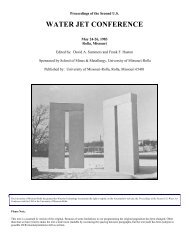proceedings of the fourth us water jet conference - Waterjet ...
proceedings of the fourth us water jet conference - Waterjet ...
proceedings of the fourth us water jet conference - Waterjet ...
You also want an ePaper? Increase the reach of your titles
YUMPU automatically turns print PDFs into web optimized ePapers that Google loves.
THE USE OF HIGH PRESSURE WATERJETS IN CUTTING FOAM<br />
S. Yazici and D. A. Summers<br />
High Pressure Water<strong>jet</strong> Laboratory<br />
Rock Mechanics Facility<br />
University <strong>of</strong> Missouri-Rolla<br />
Rolla. Missouri<br />
ABSTRACT<br />
Expanded plastic foam is increasingly being <strong>us</strong>ed as a light, inexpensive yet<br />
effective method for providing object support in packaging. However, <strong>the</strong> most effective<br />
<strong>us</strong>e <strong>of</strong> this support requires that <strong>the</strong> packaging material be carved to roughly conform to<br />
<strong>the</strong> shape <strong>of</strong> <strong>the</strong> packaged object. While this is a relatively easy accomplishment when<br />
<strong>the</strong> surrounding void is filled with small pieces <strong>of</strong> foam, it becomes more <strong>of</strong> a problem<br />
when <strong>the</strong> object contours m<strong>us</strong>t be generated in solid foam pieces. Solid foam, however,<br />
has <strong>the</strong> advantage <strong>of</strong> providing a more uniform loading <strong>of</strong> <strong>the</strong> object and holds it more<br />
rigidly in position. These requirements mandate that a simple but effective method be<br />
available for carving <strong>the</strong> foam to shape. The most prevalent <strong>of</strong> <strong>the</strong> current methods relies<br />
on ei<strong>the</strong>r manual carving <strong>of</strong> <strong>the</strong> solid block, <strong>us</strong>ing heated scoops or wires, itself an<br />
expensive and relatively slow procedure, or that <strong>the</strong> foam support be composited by <strong>the</strong><br />
glueing toge<strong>the</strong>r <strong>of</strong> <strong>the</strong> different component parts, each <strong>of</strong> which has previo<strong>us</strong>ly been<br />
manually carved to its required shape. Both <strong>of</strong> <strong>the</strong>se processes can be relatively slow and<br />
<strong>the</strong>refore also expensive.<br />
High Pressure <strong>water</strong><strong>jet</strong> cutting systems have been developed for <strong>us</strong>e as ind<strong>us</strong>trial<br />
cutting tools, with significant market penetration having occurred within <strong>the</strong> last seven<br />
years. The majority <strong>of</strong> <strong>the</strong> applications for this novel tool have, however, been directed at<br />
cutting harder and more difficult materials, with <strong>the</strong> <strong>us</strong>e <strong>of</strong> abrasive injection, or for <strong>the</strong><br />
cutting <strong>of</strong> relatively s<strong>of</strong>t materials. The range <strong>of</strong> foams which m<strong>us</strong>t be considered for <strong>the</strong><br />
current operation lies over a range <strong>of</strong> densities which fits between <strong>the</strong>se two extremes.<br />
The cutting <strong>of</strong> foam, in general, provides a material which it is extremely easy to cut at<br />
relatively rapid rates. This, in part, allows observation <strong>of</strong> cutting parameters at different<br />
ranges from those normally essayed. One requirement for <strong>the</strong> current program is,<br />
however, different to that sought for most ind<strong>us</strong>trial cutting where <strong>the</strong> cuts are made<br />
through relatively thin thicknesses <strong>of</strong> material. In contrast, in this operation, in order to<br />
cut <strong>the</strong> required contours <strong>of</strong> some <strong>of</strong> <strong>the</strong> objects to be packed, cutting depths on <strong>the</strong> order<br />
<strong>of</strong> one meter should be achievable.<br />
PROGRAM PLAN<br />
As a means <strong>of</strong> assessing <strong>the</strong> parameters required to achieve <strong>the</strong> required cutting<br />
performance, a full factorial experiment was designed. The experiment utilized a pump<br />
(Ingersoll Rand 1 ) which w a s capable <strong>of</strong> generating pressures <strong>of</strong> up to 400 MPa at flow<br />
rates <strong>of</strong> up to four liters/min. Nozzle diameters for <strong>the</strong> factorial experiment were chosen<br />
to insure that <strong>the</strong> full factorial could be completed within <strong>the</strong>se limitations. The<br />
1 The <strong>us</strong>e <strong>of</strong> trade names is for <strong>the</strong> purpose <strong>of</strong> identification only and should not be taken as an endorsement<br />
<strong>of</strong> any one particular product.<br />
21















